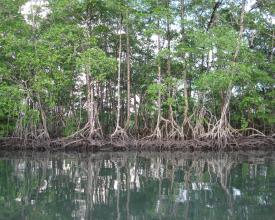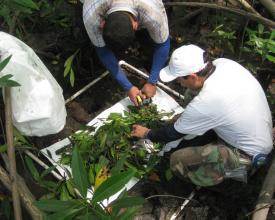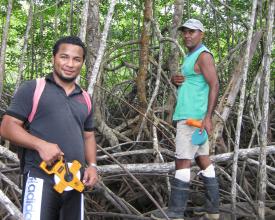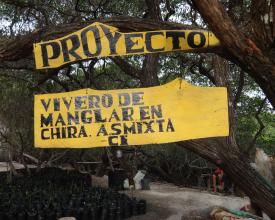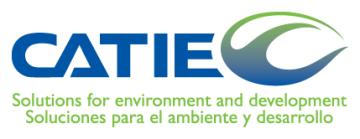
Blue Carbon A-Z: from small projects to policy development
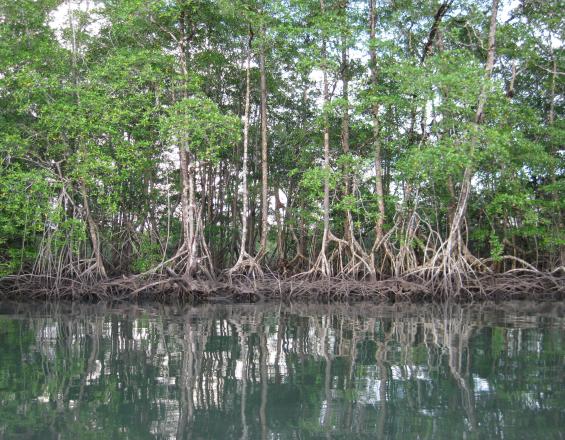
Blue Carbon is still a new concept that needs the right facilitation to kick-start projects and promote blue carbon actions. CATIE undertakes relevant steps to facilitate the development of sound scientific and political frameworks: carbon stock inventories, livelihoods and vulnerability studies, assessment of land-use dynamics and associated historical emissions, facilitation of policy development and promotion of capacities across the Central and Latin American region.
Context
Challenges addressed
Limited knowledge and guidance for blue carbon project design and implementation. Despite increasing interest in blue carbon, limited guidance is available for project developers and countries to design and implement initiatives that can offer climate change mitigation and adaptation benefits while delivering improved livelihoods to coastal communities. CATIE addresses these needs through a cohesive package of scientific research and political advising throughout the Americas.
Location
Process
Summary of the process
Building blocks can operate in concert at the local and national scales. Local carbon inventories (building block 1) and geospatial modeling (building block 3), together with livelihoods and vulnerability assessments (building block 2) provide information to prioritize site selection and inform national decision-making. Local people and government technicians can be recruited and trained so their capacities are enhanced and their experiences can be scaled up. At the national level, the development of national policy frameworks (building block 5) allow for the inclusion of blue carbon elements in national emissions accounting and budgeting, mitigation and adaptation plans, restoration strategies, national forest inventories, and REDD+ and MRV. In addition, economic valuation data (building block 4) are needed for designing financial mechanisms that will allow for potential funds transfers to promote local conservation and enhance local development. Furthermore, the integration of these building blocks across the Americas is designed to promote a regional network of blue carbon scientists and practitioners, policies and projects that integrate mitigation and adaptation goals while promoting local development (building block 6).
Building Blocks
Carbon inventories in mangrove ecosystems
Enabling factors
Lesson learned
Resources
Social and ecological vulnerability assessments
Enabling factors
Lesson learned
Geospatial and emissions modeling
Enabling factors
Lesson learned
Ecosystem services valuation
Quantifying the value of ecosystem services provided by mangroves to the local communities is a required component of blue carbon projects. This informs the design of Payment for Ecosystem Services (PES) schemes. As a full valuation is challenging and costly, priority services are chosen through a participatory consultation process with local communities. Raw data are collected locally and mined through bibliographic searches and interviews. Results emphasize the importance of coastal-marine ecosystems with decision makers, as mangrove losses can be explained as capital losses.
Enabling factors
The availability of local and national data is a determining factor for an adequate valuation of ecosystem services. Even when those data are not available relationships with local officials may provide useful expert criteria and inputs. Also, the participation of the communities in the diagnostics to identify and later quantify priority services is important to guarantee their buy-in into the process. A clear understanding of local livelihoods is also necessary.
Lesson learned
Local perceptions of what constitutes a “priority” ecosystem service for valuation may differ from that of project developers and researchers. In addition, data constraints may limit the extent of the valuation study. It may thus be necessary to negotiate with locals during the preliminary diagnostics phase what services meet their needs and those of the project, and which can be valued. The wide range of services provided by mangroves and surrounding coastal-marine ecosystems make a full valuation exercise very challenging. Thus, most valuation studies are partial and depend on a set of assumptions and a variety of different methods. Good working relationships with government representatives in charge of data processing and archiving, as well as a solid understanding of the details of the local livelihoods and business models is highly advantageous, which is why a livelihoods study should be conducted in parallel.
Development of national policy frameworks
The existence of robust policy frameworks facilitates the design and implementation of local and national blue carbon initiatives. These policies promote official government support and the foundation for institutional roles, and offer links with other national and international policies, mechanisms and strategies (such as NDCs, REDD+ and NAMAs). The policy building process starts with informal consultations with national authorities to map actors, gauge their interest and obtain their support. As these are national-scale constructs, strategic advice and facilitation of the process is important.
Enabling factors
Of utmost importance is to garner the interest and support of national authorities in decision-making positions, as policy development is a government role and must not be imposed onto a country. The existence of other environmental, coastal-marine or climate change policies enables the alignment or incorporation of blue carbon policy notions within pre-existing policies. The availability and communication of sound science for the public is also important during policy development.
Lesson learned
Our experience has been that an initial ‘socialization’ (supply, introduction and communication) of basic blue carbon information and principles is needed through formal and informal meetings with country officials at multiple levels of decision-making. Then, a clear understanding of current country needs and priorities, and how they can be met through blue carbon actions, should be considered to ensure the process is compatible with on-going national processes and international climate change and conservation commitments. The role of the people facilitating the policy process is key to deliver sound information, to understand country needs, to ensure that the interests of different actors are met, to negotiate complex matters and to mediate conflicts that may arise. The pace at which governments respond to specific processes is not necessarily compatible with the short-term goals of local project development and implementation or international cooperation.
Resources
Promoting blue carbon networks
Enabling factors
Lesson learned
Impacts
Social: In the Gulf of Nicoya, Costa Rica, people from local organizations see their capacities enhanced and they are further empowered to conserve mangrove resources through a better understanding of their importance for climate change mitigation and adaptation. Economic: We provided the first ever estimate of (mangrove) natural capital loss due to mangrove area losses in the Gulf of Nicoya, Costa Rica. Ecological: The Government of El Salvador committed to doubling by 2016 the area of mangrove forests under sustainable management plans due to blue carbon interventions started in 2014.
Beneficiaries
Governments and greenhouse gas inventorying, reporting and verification institutions
Sustainable Development Goals
Story
CATIE is leading blue carbon science and policy development across Central America. We started with small carbon inventory projects in Costa Rica, which have now been replicated in Panama, El Salvador and Honduras. Other building blocks were later incorporated into our implementation package as further interest in blue carbon was promoted. A recent project in the Gulf of Nicoya, Costa Rica, exemplifies the integration of many of the building blocks described in the solution. We partnered with Conservation International to develop a participatory project that would involve mangrove restoration, capacity building of local organizations and people ranging from school age to adults, a livelihoods assessment, a climate change vulnerability study coupled with proposed local adaptation strategies, valuation of ecosystem services, and ecosystem-level carbon inventories. In parallel, we are facilitating the development of a blue carbon strategy and action plan for the country, which will be part of the larger National Wetlands Policy statement that the Government of Costa Rica is developing. Results from this and previous projects have been showcased in the local news and social media, which has triggered interest in blue carbon in the country and elsewhere in Central America. This has led most countries in the region to recognize the importance of mangrove forests as critical sinks of carbon and include them as separate strata in their national forest inventories and REDD+ (Reducing Emissions from Deforestation and Forest Degradation) MRV (measurement reporting and verification) plans. It is inspiring to see how something that started as a small pilot research project in a protected area in Costa Rica has fueled dialogues across Central America, Mexico, and even as far south as Ecuador, and now has the potential to serve as the basis for much larger scientific and political collaborations. We still face challenges related to project design (i.e. good practice guidelines and standardized international standards and methodologies) and implementation (i.e. ensuring projects can deliver social benefits, increase resilience of coastal communities, and enhance local livelihoods) but we are confident that funding streams and further international support will allow us to continue delivering the best quality blue carbon solutions in Central and South America.
